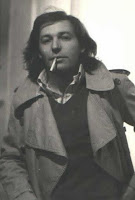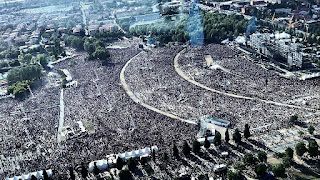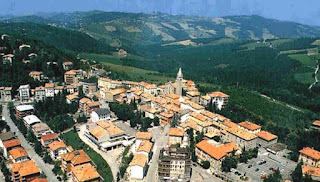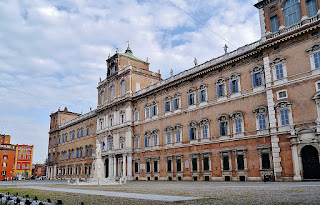Nicola Salvi – architect
Creator of Rome’s iconic Trevi Fountain
The architect Nicola Salvi, notable as the designer of the Fontana di Trevi – known in English as the Trevi Fountain and one of the most famous and most visited monuments in Rome – died on this day in 1751. He was working on the Trevi when he passed away, having been engaged on the project since 1732. It had to be finished by Giuseppe Pannini and the giant statue of Oceanus – the Titan God of the Sea in Greek mythology – set in the central niche, was completed by Pietro Bracci, yet Salvi takes credit as the lead architect. Salvi ran a workshop in Rome that he had taken over when his master, Antonio Canevari, left the city in 1727 to take up a position working as architectural consultant to the king of Portugal in Lisbon. He completed a number of commissions on behalf of Canevari but spent a good deal of his time tutoring others and might have made very little impression on architectural history had he not submitted entries for two design competitions run by Pope Clement XII in 1732. One was for a new façade for the church of San Giovanni in Laterano, for which his design was commended. Read more…
_____________________________________
Guercino - Bolognese master
Self-taught artist amassed fortune from his work
The artist known as Guercino was born Giovanni Francesco Barbieri on this day in 1591 in Cento, a town between Bologna and Ferrara in what is now the Emilia-Romagna region. His professional name began as a nickname on account of his squint - guercino means little squinter in Italian. After the death of Guido Reni in 1642, he became established as the leading painter in Bologna. Guercino painted in the Baroque and classical styles. His best known works include The Arcadian Shepherds (Et in Arcadia Ego - I too am in Arcadia), showing two shepherds who have discovered a skull, which is now on display at the Galleria Nazionale di Arte Antica in Rome, and The Flaying of Marsyas by Apollo, which can be found in the Palazzo Pitti in Florence, both of which were painted in 1618. Guercino's frescoes were notable for the technique of creating an illusionist ceiling and would make a big impact on how churches and palaces in the 17th century were decorated. Mainly self-taught, Guercino became apprenticed at 16 to Benedetto Gennari, a painter of the Bolognese school, at his workshop in Cento before moving to Bologna in 1615. Read more…
_____________________________________
Italo Santelli - fencer
Olympic medallist famous for real ‘duel’
The Olympic fencer Italo Santelli, who famously fought a duel with his former team captain over a matter of honour, died on this day in 1945 in Livorno, Tuscany. Santelli won a silver medal at the 1900 Olympics in Paris with a new style of sabre fencing of his own invention. Originally from Carrodano in Liguria, he fought for Italy but spent a large part of his career coaching Hungary, who he helped become a formidable power in fencing. It was this conflict of interests that sparked an incident at the 1924 Olympics, also in Paris, that led to Santelli and Adolfo Cotronei, who was Italy’s team captain, engaging in the infamous duel. It happened during a match between the Italians and the host nation France in the team foil event when Italy’s Aldo Boni was facing off against Lucien Gaudin. With the match tied at four touches each, the Hungarian judge György Kovacs awarded the winning fifth touch to Gaudin, a decision that sparked immediate consternation in the Italian ranks. Boni rounded on Kovacs, delivering a verbal tirade. But it was in Italian - beyond the official’s comprehension. It just happened that Santelli, in his capacity as Hungary’s coach, witnessed the whole dispute and was asked to step in as interpreter. Read more…
_____________________________________
Giuseppe Torelli – violinist and composer
Brilliant musician could both perform and write beautiful music
Talented musician Giuseppe Torelli, who played the viola and violin and was a composer during the late Baroque era, died on this day in 1709 in Bologna in Emilia-Romagna. He is remembered for contributing to the development of the instrumental concerto and for being the most prolific Baroque composer for trumpets and he is ranked with Arcangelo Corelli as a developer of the Baroque concerto and concerto grosso. Torelli was born in Verona in 1658. He learnt to play the violin and studied composition with Giacomo Antonio Perti. At the age of 26 it is known that he was a member of the Accademia Filarmonica as a violinist. Two years later he was employed as a viola player at the Basilica di San Petronio in Bologna. He stayed there for about ten years until the orchestra was disbanded because of financial constraints. His first published works were ten sonatas for violin and basso continuo and 12 concerti da camera for two violins and basso continuo. Around 1690 Torelli began writing his first trumpet works. It is considered unusual for a strings player to compose works for the trumpet. Read more…
_______________________________________
Revolt in Padua
When students and citizens joined forces against their oppressors
An uprising against the Austrian occupying forces, when students and ordinary citizens fought side by side, took place on this day in Padua in 1848. A street is now named Via VIII Febbraio to commemorate the location of the struggle between the Austrian soldiers and the students and citizens of Padua, when both the University of Padua and the Caffè Pedrocchi briefly became battlegrounds. The Padua rebellion was one of a series of revolts in Italy during 1848, which had started with the Sicilian uprising in January of that year. The Austrians were seen as arrogant and aggressive by ordinary citizens and the ideas of Giuseppe Mazzini and Camillo Benso Cavour about a united Italy were becoming popular with progressive thinkers. Students and professors at Padua University had been meeting in rooms at the University and in Caffè Pedrocchi to discuss their discontent. The uprising began with the storming of a prison and prisoners being set free. Then many ordinary citizens came to fight alongside the students against the armed Austrians, who clubbed the Paduans with their guns as well as firing at them. Read more…
_______________________________________
Book of the Day: Not Built in a Day: Exploring the Architecture of Rome, by George Sullivan
Not Built in a Day: Exploring the Architecture of Rome is a unique, unconventional guide and a deeply felt homage to Rome and its extraordinary 2,500-year history. Moving beyond the names, dates, and statistics of ordinary guidebooks, George Sullivan's eye-opening essays celebrate the special character of Rome's buildings, fountains, piazzas, streets, and ruins. From the largest landmark down to the smallest hidden gem, Not Built in a Day explores the city in comprehensive detail, offering detailed visual and historical analyses that enable readers to see and understand exactly what makes the architecture of Rome so important, influential, and fascinating. The book is supported by a companion website (NotBuiltInADay.com) that offers, among other features, detailed illustrative photographs for readers who want to experience the book's walking tours at home and large printable maps for readers using small electronic devices on-site in Rome.
George H Sullivan is a veteran travel writer whose work includes walking tours of both Florence and Vienna for Fodor’s Travel Guides. A lecturer on Roman architecture at the Smithsonian Institution in Washington, DC, he spent 15 years researching and writing the essays that became Not Built in a Day.



.jpg)







.jpg)

.jpg)




.jpg)














.jpg)



